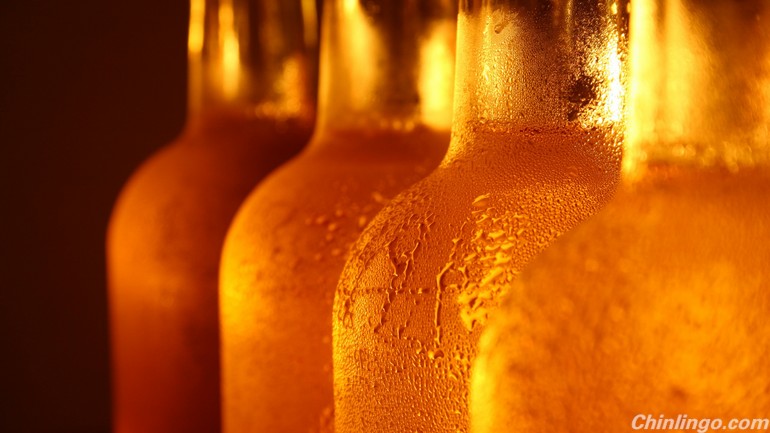
The cause of and solution to many of the problems faced while in China,
the various alcohols found on tap or in bottle in the Middle Kingdom are
as abundant as they are varied. From China’s staple baijiu, to the
widely-available domestic brand beers and wines, there is no shortage of
firewater to either complement or replace a meal with.
Baijiu: The White Devil
There are many jokes starting with “You know you’ve been in China too
long when …” but one of the most accurate surely is “You know you’ve
been in China too long when you enjoy a nice glass of bái jiǔ.”
Usually made by distilling sorghum, it is not unlike vodka in looks.
The similarities end there however. Its subtle sweetness gives one an
initial this ain’t so bad feeling, which is often followed by
panic and a rapid search of your memory for all available objects that
might assist you in removing it from your system. At 80-120% proof,
baijiu ranges from spicy bite to paint strippingly alcoholic. There are
numerous brands of baijiu, but two of the most well-known are Maotai and
Er Guo Tou.
Pijiu: An Ale For All Your Ills
Though slow to start in China, beer (pí jiǔ) has very likely replaced baijiu as the most drunk drink in the country. Beer in various forms has a long history in China, but it is largely considered to have been introduced a little over a century ago by the Germans.
Typically pilsner lagers, Chinese beer comes in bottles larger than
what are standard in many Western countries. With your average
straight-out-of-Missouri Budweiser bottle measuring in at about 350 ml,
it is easily overshadowed by the 500-750 ml bottles of Chinese brew.
Tsingtao is the nation's #1 fizzy export, and has a huge domestic
following as well. Brewed in the city of its moniker, Qingdao, Shandong,
it is widely available and is generally quite cheap. Like its distant
cousin, baijiu, Chinese beer also has a plethora of brands to choose
from, and most locals have their intra-city/province label of choice.
In most mom & pop restaurants you'll pay 5-10 RMB per bottle,
with the price rising to 10-30 RMB at bars and clubs. Shops will often
sell the cheap brands for 2-5 RMB, but may charge you a bottle deposit
(often just written on random bits of cut-up cardboard) to assure you’ll
bring the bottles back to them.
Wines
Wine has exploded in China in recent years. In most major cities you’ll be able to find a selection of red (hóng pú táo jiǔ or simply hóng jiǔ) and white (bái pú táo jiǔ) wines.
Though popularity is still rather elitist, China's growing
middle-class is fueling a burgeoning industry of competitively priced
good drinkable wines. Rieslings, and Merlots might require a bit of a
hunt, but even small supermarkets and some shops typically carry a range
of Cabernet and Chardonnay. Prices vary greatly, as they do in any
country, but you can find cheaper and not terribly tasting bottles for
40-60 RMB, and a decent bottle for around 70-100 RMB.
Spirits/Hard Liquor
Often small Chinese shops wont carry much in the way of spirits (with
baijiu and possibly vodka as two exceptions), but larger supermarkets
will almost always have a wide selection — from Hennessy and Johnnie
Walker to Smirnoff and tequila, as well as a variety of liqueurs.
The more upscale Chinese-style bars will almost always feature a
collection of rather rich men surrounded by young women drinking an
expensive bottle of liquor mixed with green tea and playing dice games.
These are supplemented with more Western-style clubs that will sell you
shots at the bar.
There are no large domestic brands of whiskey, vodka, or rum. Imports
are the rule, and as such, expect to pay prices similar to home.
However, if you come from a country with heavy sin taxes, you might find
prices in China a bargain.
Culture Notes:
China is full of heavy drinkers, at near all times of the day. Drinking and driving, though outlawed, is common. Largely due to face,
it's not as common for a friend or colleague to tell someone that
they've had too many and they should leave the keys with the bar and
call a cab. An important tid-bit to remember when crossing roads,
especially post mealtime.Despite claims of China being very egalitarian in regards to women's
rights, it is generally frowned upon in Chinese culture for a woman to
be seen drinking (or smoking) much if anything in public. As would be
expected, it's not such a big deal at Western-style bars or restaurants;
however, it may be something to remember if you’re meeting your Chinese
boyfriend's parents for the first time.



 闽公网安备 35020302035673号
闽公网安备 35020302035673号
0 responses on "How many kinds of Chinese alcohol do you know?"